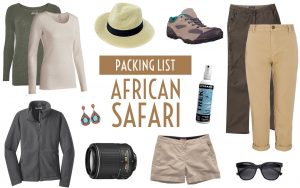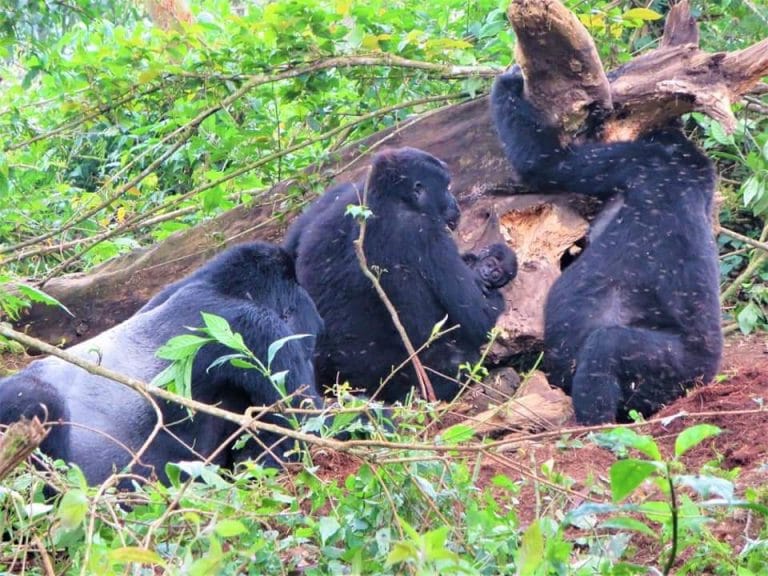What to Pack for an African Safari
What to Pack for an African Safari
What to Pack for an African Safari is vastly different than packing for just about any other trip, and it’s often a challenge for first time safari goers. Not only do most safari goers have weight restrictions on bush flights (a typical weight restriction is 15 kilograms or 33 pounds total per person, including camera equipment and carry-ons), but you also have the challenge of knowing which types of clothes to wear on safari are appropriate.
 Preparing What to Pack for an African Safari
Preparing What to Pack for an African Safari
What to Pack for an African Safari isn’t just about the clothing, either. There’s a lot of little quirky things about traveling to Sub-Saharan Africa that you need to know before you go. We either got tips in advance from the awesome safari companies we went with, or learned about various policies along the way.
We break everything down for you below with further explanation, but your packing list for safari should include the following essentials and will work no matter if you need a 2-day or 2-week safari packing list:
- duffel or soft-sided bag
- TSA approved clear toiletry case
- 2 pairs of pants in a breathable fabric in earth tones
- 1 – 2 long sleeve shirts in chambray or earth tones
- 3 layering tanks or tshirts
- utility jacket
- light scarf
- sports bra
- wide brim hat with chin strap
- closed toe shoes like trail runners or fashion sneakers with good traction
- waterproof dry bag
- moisturizer
- sunscreen
- insect repellent with Deet
- conditioner
- lip balm
- plug adapters / convertors
- USB flash drive
- Memory cards for your camera
- first aid kit
1. Prepare your documents
Many countries in Sub-Saharan Africa require your passport to be valid for six months beyond your travel dates in Africa. They also have requirements like a certain number of consecutive blank pages being available in your passport. So be sure to pull out your passport well in advance of your trip, and thoroughly review all the entry requirements for each country you’re visiting.
2. Cash is king in Africa
You won’t find credit card machines in the African bush and you’ll likely visit at least one village where you can pick up some unique souvenirs. US dollars are fairly widely accepted, and you can also easily take out local currency from an ATM when you arrive at the international airport.
Know that tipping is common throughout Sub-Saharan Africa and you should have cash on hand to tips guides and service staff. Your safari company should answer questions and provide a guide on tipping etiquette. In our experience for a luxury safari, you should plan to tip your guide between $20 – $30 per day per couple.
3. Prescription glasses (sunglasses, hat, sunblock et al)
If you wear prescription glasses, be sure to pack more than one set (in case you lose one or they get broken). You will be outdoors for much of the time, so be prepared. Pack a hat, sunblock, long sleeves, and lip balm.
4. Camera, video and binoculars
Whilst most people will remember to take their camera and/or video (or will use their mobile phone), not everyone thinks they need to take binoculars!
5. Clothes and toiletries
Of course you’re not going to forget clothes! But are you taking the right clothes…and are you within those weight restrictions your travel agent told you about for those light aircraft flights?
6. Phone, music, tablet or laptop
What you must pack for your safari are your phone, music, tablet or laptop – and their respective chargers, country-specific adaptor plugs.
7. Preventative pharmaceuticals
This is just a fancy way of saying ‘meds’ – stuff you need, just in case the worst happens: diarrhea, headaches, heartburn, insect repellent, hand sanitizer, bites (antihistamine), indigestion, sore throat (lozenges), eye drops, and most important – anti-malarial tablets.
8. Odds & ends
A good torch (flashlight) is a must.
It can be pitch black in the bush or in your tent in the middle of the night. A rechargeable torch is ideal but a small battery-powered torch is sufficient. The new LED miner’s lights that fit on your head (and leave your hands free) are also a good option. A smaller (pencil) torch for emergencies or looking at star maps is also worth considering. Most camps will provide a torch, or will walk you back to your tent as required, but being self-sufficient is always a good idea.
A good book.
It never hurts to have an interesting book when travelling. You never know when you are going to be delayed at the airport or fall victim to Africa time!
A travel diary or journal is something we recommend.
You will see and experience so much in such a short period of time on safari, that the only way to maintain a good record of it will be to write it down. It does require discipline, but will serve as an invaluable record of your safari adventure.
9. Pack For a Purpose
Many safari camps and lodges now support local community initiatives in and around the wildlife parks, reserves and concession areas. If you want to make a positive difference during your time away, ask if you can bring any supplies that will help these projects (usually school supplies, medication or clothing).
10. Finally, don’t forget your sense of humor, patience and some common sense!
A word (or two) of warning:
It is not advisable to wear any form of clothing that may be construed as “camouflage”. By this we mean any form of brown/green “combat” style coloring. Even if it is the latest fashion statement – and even if it is your 14 year old wearing it – and even if it is just a cap. Many African authorities have a disproportionate phobia about such garments and this could conceivably result in you being questioned or harassed by the police. It has the potential to cause you grief, so don’t do it.

